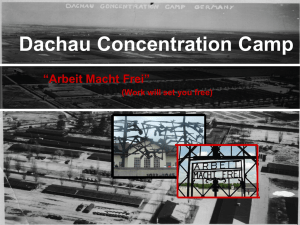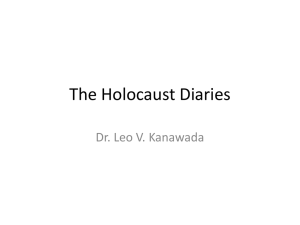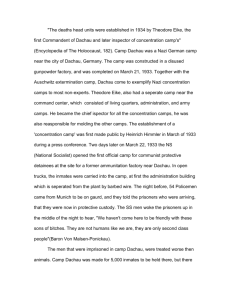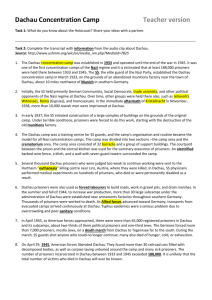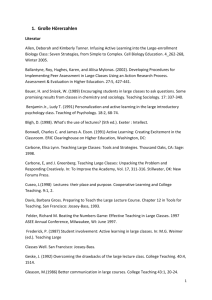Prospectus of a dissertation
advertisement
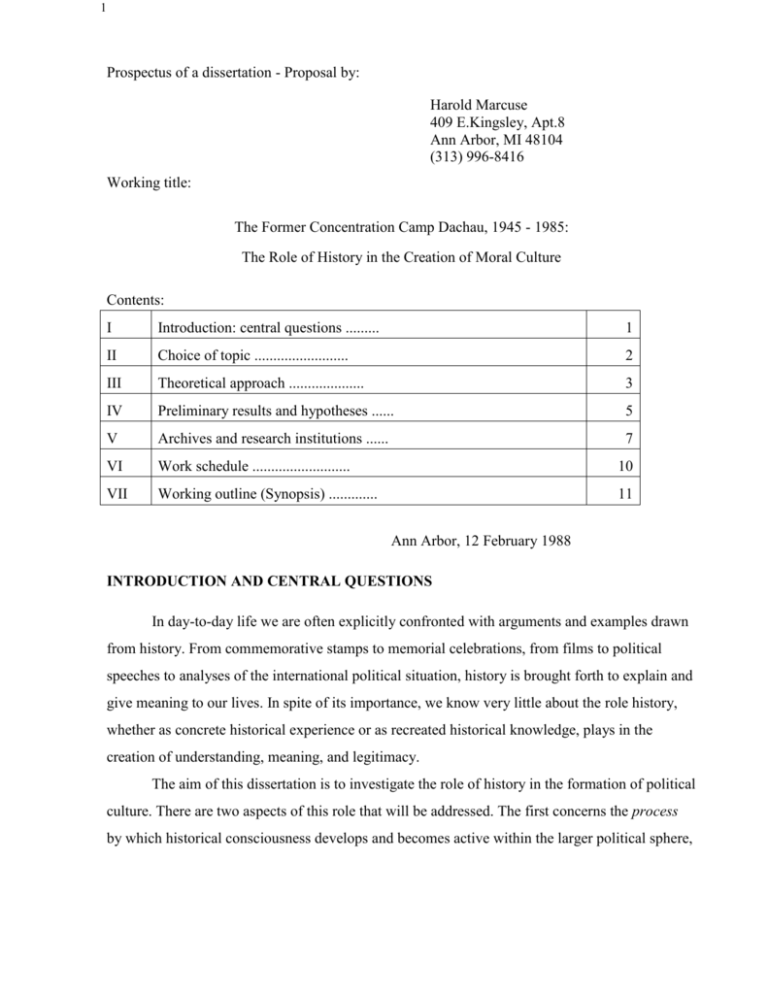
1 Prospectus of a dissertation - Proposal by: Harold Marcuse 409 E.Kingsley, Apt.8 Ann Arbor, MI 48104 (313) 996-8416 Working title: The Former Concentration Camp Dachau, 1945 - 1985: The Role of History in the Creation of Moral Culture Contents: I Introduction: central questions ......... 1 II Choice of topic ......................... 2 III Theoretical approach .................... 3 IV Preliminary results and hypotheses ...... 5 V Archives and research institutions ...... 7 VI Work schedule .......................... 10 VII Working outline (Synopsis) ............. 11 Ann Arbor, 12 February 1988 INTRODUCTION AND CENTRAL QUESTIONS In day-to-day life we are often explicitly confronted with arguments and examples drawn from history. From commemorative stamps to memorial celebrations, from films to political speeches to analyses of the international political situation, history is brought forth to explain and give meaning to our lives. In spite of its importance, we know very little about the role history, whether as concrete historical experience or as recreated historical knowledge, plays in the creation of understanding, meaning, and legitimacy. The aim of this dissertation is to investigate the role of history in the formation of political culture. There are two aspects of this role that will be addressed. The first concerns the process by which historical consciousness develops and becomes active within the larger political sphere, 2 and the second is concerned with the nature of the political process itself, specifically its character in terms of what I will call macro-social morality, or "moral economy". These objectives are to be pursued on the basis of a case study: the history of the former concentration camp Dachau from its liberation in 1945 down to the celebration of the fortieth anniversary of that event in 1985. The questions to be asked include: What happened at the site (after the war), and when were the turning points in its history?, How was the camp, as a historical symbol, understood and utilized during each period? How did common perceptions of the camp relate to what we (now) think actually happened there? How did the transitions from period to period come about?, and How do these changes reflect developments in the moral nature of the broader political culture? CHOICE OF TOPIC There are several factors that make an investigation of the Dachau former concentration camp in the history of the Federal Republic especially suited to answering these questions. For one thing, although the moral consequences of historical legacies are often intensely discussed after the demise of any repressive regime (Soviet Union 1956ff, Argentina 1985ff), the Nationalsocialist state differed from other dictatorships in that its policies of domestic and international terror and repression were judged to be particularly heinous. The Nuremberg trials are a prime example of this - they were the first attempt to explicitly set forth moral guidelines for social conduct and responsibility.1 The conjuncture of moral exigency, foreign interest, and a welldeveloped sphere of public discourse ensured that the National-socialist system of terror would both play a key role in the building of historical consciousness in Germany and be a focal point of discussions involving social morality. Given the complex nature of the National-socialist system, it would be difficult, if not impossible to investigate the reception and discussion of all of its aspects. Thus I have decided to investigate the history of the afterlife of a concentration camp, since the camps have come to 1 The 1899 and 1907 peace conferences in the Hague represent much more limited attempts to create moral guidelines for state and societal conduct. 3 represent the institutionalized system of domestic and foreign terror. Most other remnants of the Nazi state disappeared or were consciously destroyed in 1945: the Party, the administrative and judicial systems, and the many party-controlled organizations. Only the victims and the physical remains of the instruments of repression were left to remind of the terror apparatus. The former concentration camps are especially suitable for an analysis such as this: they confronted and confront not only through personal memories and narrative reconstructions, but also as physical entities. Their symbolic character makes them more "objective" objects of historical study than groups of survivors. Dachau is the obvious choice among the various former camps and prisons in the Federal Republic for historical and historiographical reasons. It was the first concentration camp erected in Germany, and in it the administrative system later instituted in all of the camps was developed.2 It was thus in a very real sense a model for the core of the repressive system. As such, it can be taken to stand for the whole.3 Additionally, since Dachau was by far the best known concentration camp with the largest organization of survivors on what was to become West German soil, the most comprehensive record of post-war confrontation with it has been preserved. Situated near a small town but under state jurisdiction, Dachau lends itself to the analysis of historical experience at the local and regional, as well as national and international levels. THEORETICAL APPROACH The German sociologist Jürgen Habermas' concepts of the bourgeois and plebian public spheres (Strukturwandel der Öffentlichkeit, 1962, expanded by O.Negt and A.Kluge in 19724) will provide the theoretical background for the first analytical section of this dissertation (cf. 2 See: Günther Kimmel, "Das Konzentrationslager Dachau", in: Bayern in der NS-Zeit, vol.2, ed. by M.Broszat and E.Fröhlich, (Munich: Oldenbourg, 1979); Hans-Günter Richardi, Dachau. Schule der Gewalt (Munich: Beck, 1981), and Tom Segev, The Commanders of Nazi Concentration Camps, Ph.D. Diss., Boston Univ., 1977. 3 A broad spectrum of groups were subjected to institutionalized terror at Dachau. In fact, all groups persecuted under the NS-regime except for women were imprisoned there. Since Ravensbrück, the camp for women, was institutionally identical to Dachau, the latter retains its representative character. 4 Oskar Negt and Alexander Kluge, Öffentlichkeit und Erfahrung. Zur Organisationsanalyse von bürgerlicher und proletarischer Öffentlichkeit (Frankfurt: Suhrkamp, 1972). 4 working outline, III.). Since these concepts were derived for a Marxist analysis of world-historical change, however, I have found it more useful to analyze the presently existing public sphere in terms of a hierarchy of communicative sub-spheres, classified according to their geographic range. Thus both the bourgeois and proletarian structures of "the" public sphere figure in the local, regional, national and international levels to be studied here. The development of meanings within the individual spheres of discourse, and the interactions between those spheres are the subject of the following section of the dissertation (IV.). Here the work of the French philosopher-historian Michel Foucault figures prominently in my analysis. Foucault's "archaeological" method should enable me to deconstruct the terms of discourse in the various discursive fields and study their interaction. Through such an analysis I hope to come closer to understanding the process of formation of opinions, and ultimately political culture. In his seminal work The Making of the English Working Class (1963), E.P. Thompson introduced the term "moral economy" to describe the dependence of economics on cultural expectations in pre-industrial society. In the final section of this dissertation (V.) I will use a broader notion of that concept to denote the interplay between cultural factors (e.g. traditions of individual and social behavior, mentality, ideals) and the political and economic systems. The analysis of the nature and development of this kind of "moral culture" will be based on approaches suggested by a number of authors. In an essay entitled 'Can complex societies build a rational identity?' (1975), JÜrgen Habermas attempted to redefine psychological categories of individual moral development to denote different forms of macro-social morality. The categories of psychologist Leo Kohlberg, upon which Habermas based his theory, have since been subjected to a cogent critique by the feminist psychologist Carol Gilligan.5 The works of Gilligan and a number of her followers have important implications for theories of moral culture, since they are based on broader underlying structures, not simple developmental schemes. Finally, the moral philosopher Günther Anders 5 See Carol Gilligan, In a Different Voice: Psychological Theory and Women's Development (Cambridge: Harvard, 1982), and Eva Kittay and Diana Meyers (eds.), Women and Moral Theory (Totowa, N.J.: Rowman and Allenheld, 1987). 5 has examined the actual nature of macro-social morality during the national-socialist period and in the atomic age.6 His writings provide examples of analyses of actual moral systems. Some examples may serve to clarify the meaning of macro-social morality. Apparently all resistance to an established regime is based upon ethical systems which conflict with the norms of the hegemonic moral culture. The resistance of the communists to Hitler's government was based on Marx' economic humanism (evidence suggests that the Hitler-Stalin pact didn't affect the activities of many of the cadres). Religion and religious humanism forced the interruption of the so-called euthanasia program and motivated groups such as the "Weiße Rose". The conservative-military resistance culminating in the assassination attempt of 20 July 1944 drew its justification from a traditional paternalistic military ethic. Finally, internationalism and criticism of instrumental "enlightened" morality provided an ethical basis for the "Kreisauer Kreis". PRELIMINARY RESULTS AND HYPOTHESES The first premise of this thesis, the existence of a set of interconnected discursive subspheres, will only prove its utility after I have collected much more data and begun to analyze it. However, a comparison of two key events can serve to illustrate the general procedure of analysis that I am proposing (cf. IV, A and B of the working outline). Refugees from Eastern Europe quartered in run-down barracks in Dachau-Rotschwaige went on a hunger strike in the summer of 1948 in order be relocated into the former concentration camp. The Americans were phasing it out as a war criminals' compound, and it offered far better living conditions than Rotschwaige. Concurrent protests were staged at a number of other refugee camps throughout Bavaria, and the participation of Albert Schweitzer and students at the International Summer University in Munich, coupled with a neutral-to-sympathetic response from the populace, set the administrative apparatus in motion. Within five months the refugees had been relocated. It appears that skillful control of the regional sphere of discourse, with the potential for 6 Anders' systematic theories as put forth in Die Antiquiertheit des Menschen (vol.1, 1956; vol.2, 1980) are often less explicit than his book about the Hiroshima-pilot Claude Eatherly (1961) and his 'open letter' to Adolf Eichmann's son (1964). Some of the sketches in his Ketzereien (1982) are also extremely valuable (e.g. p.139ff.). 6 international attention, but without any strong local feelings, led to the particular outcome. The language used in the argumentation can be characterized as humanist and pragmatic. The refugees demanded better treatment and basic rights, and the former concentration camp was considered to be an unused complex of buildings without any special significance. The few counter-arguments were based on the "eastern" origins of the refugees; the historical legacy of the camp did not figure at all. About seven years later, the small exhibition that had been set up in the crematorium was the subject of intense local debate. At the same time, foreign and regional former prisoners expressed their dissatisfaction with the refugee settlement, which was becoming more and more permanent. In the short run (until ca. 1960) these issues received neither national nor international attention. The exhibition was cleared out, but plans to relocate the settlement were put on ice for several years. In this case, the arguments were framed in quite different terms. Consonant with the dominant work ethic during the "economic miracle" of the 1950s, the utility of the camp put it beyond reproach, even though living conditions in it were by then well below standard. Conversely, the historical legacy of the camp was perceived primarily as a burden, fettering potential expansion. The voices calling for historical reflection were drowned out by the clamor of economic progress. The pragmatic humanism of the earlier debate had been replaced by economic utilitarianism - the definition of value according to economic utility. Based on such superficial analyses, it will only be possible to speculate about the mechanisms of interaction within the public sphere. It seems that at the local and regional levels moral culture is closely linked to the concerns of daily life, whereas higher levels tend to have a discourse based on more abstract and universal principles. Similarly, only hypothetical generalizations can be made about changes in the moral culture. There appears to have been a progression from a more universalistic orientation in the later 1940s to a work-centered ethic in the 1950s. The 1960s seem to have seen the development of a parallel strand of core values centered around a socialist, anti-capitalist critique. With the retreat of the student movement in the early 1970s, this strand appears to have lost some ground, but it gained in strength again after the middle of the decade. 7 In each of these periods, historical experience and arguments drawn from reconstructed history - specifically from the history of the Third Reich - played a widely varying role in the political process. Overall, the trend seems to have been one of increasing importance, perhaps culminating in the debacle of Bitburg and Bergen-Belsen in 1985, but by no means limited to it. At the grass-roots level, too, the role of historical experience has become increasingly manifest. ARCHIVES, LIBRARIES AND RESEARCH INSTITUTIONS Dachau: The archive/library of the KZ-Gedenkstätte contains a comprehensive collection of all monographs pertaining to the Dachau camp, protocols of the Allied trials, records of trial lawyers, and the correspondence and publications of the organizations of former prisoners. Newspaper clippings have been saved systematically since the early 1970s, and a wide collection of taped and videotaped interviews are available. The Dachau Stadtarchiv contains records of the city council and perhaps other relevant materials. Mr. Hans-Günter Richardi maintains a private archive with assorted holding about the postwar years, including materials on Pater Roth. Munich: The Hauptstaatsarchiv contains microfilms of US military government files; protocols of a series of discussions between the American Commandant the responsible German Landrat in 1945; files from the ministry of work covering activities in Dachau during the period July 1947 to July 1951; and relevant records from the ministry of finance and the former ministry of special problems (Sonderaufgaben). The Stadtarchiv, the archives of local party offices, of the archbishopric and of the local branch of the Deutscher Gewerkschaftsbund may contain pertinent materials. Clipping collections and possible audio and video material are held by the Süddeutsche Zeitung and the Bayrischer Rundfunk. The Institut für Zeitgeschichte contains a large research-oriented library and some archival materials, including a biographic index and the memoirs of well-known regional figures (e.g. Alois Hundhammer). The Bayrische Verwaltung der staatlichen Schlösser, Gärten und Seen, which has been responsible for the memorial site since 1965, may allow access to some of its files. Bonn: Archiv der sozialen Demokratie, Archiv für Christlich-Demokratische Politik, and other party archives contain papers and memoirs from regional and national politicians, many of whom were imprisoned at Dachau or had to deal with the camp after the war (e.g., Kurt Schumacher, who was a Dachau "Sonderhäftling"). Additionally, relevant materials concerning regional groups (Bezirksvorstand, SDS) might be held. Braunschweig: Georg-Eckart-Institut für Internationale Schulbuchforschung. 8 Frankfurt: The Vereinigung der Verfolgten des Naziregimes maintains a library and archive; some published works not available elsewhere may be kept at the Deutsche Bibliothek. The Deutscher Rundfunkarchiv is also in Frankfurt. Göttingen: Institut für den wissenschaftlichen Film. Hamburg: Arbeitsstelle für Exilliteratur houses a collection on "Literatur als Bearbeitungsform der nationalsozialistischen Verfolgungsinstitutionen". Library and Archive of the memorial site at Neuengamme (many Austrians involved in resistance in Dachau were sent to Neuengamme as punishment, most importantly Hans Schwarz, whose paper are held by the Arbeitsstelle zur Erforschung der Geschichte des Nationalsozialismus und der Arbeiterbewegung). Koblenz: the Bundesarchiv might preserve relevant materials. Ludwigsburg: Zentralstelle für die Dokumentation und Verfolgung nationalsozialistischer Verbrechen. Nürnburg: Because of its important role during the Nazi period and its proximity to Dachau and Flossenbürg, Nürnberg's Stadtarchiv might preserve relevant materials. Stuttgart: Bibliothek für Zeitgeschichte. West Berlin: Bibliothek des deutschen Widerstands, Max-Planck-Institut für Bildungsforschung. Amsterdam: The Oorlogsstichtingsinstitut probably contains Dachau-related materials; it is the repository of the papers of Nico Rost, a central figure in the post-war history of the camp. Paris: The national archive contains records of the French investigative comittee in 1951, and records from the ministry of war veterans and resistance fighters are stored there. Vienna: The Dokumentationsarchiv des österreichischen Widerstands is likely to hold relevant materials (memoirs), since a high proportion of the prisoners in Dachau were Austrian. Also, the national archive might have pertinent holdings, since official Austrian delegations often visited Dachau. London: National Records Office, Imperial War Museum. New York: YIVO Archive, Center for Holocaust Studies, International Jewish Congress, Leo Baeck Institute, United Nations. Washington, D.C.: The National Archives hold materials pertaining to the liberation, war criminals' camp and de-nazification. 9 WORK SCHEDULE The logical starting point for research is the archive and library at the Dachau Concentration Camp Memorial Site. I think it would make the most sense to base myself in Dachau/Munich for the first 7-8 months of my stay. It will first be necessary to work through the newspaper clippings and the collections of monographs in order to construct a detailed chronology and identify likely repositories of additional source material. After having done most of this groundwork (4-5 months), I would begin to visit some of the specialized libraries scattered throughout West Germany, planning to spend longer periods (ca. 2 weeks) at the more important cities (Bonn, Frankfurt, Berlin). I think it could be fruitful to look for relevant source material at other Bavarian cities (Augsburg, Landsberg, Nürnburg, Regensburg), since this would help to round out the "regional" picture. Depending on the results of my continuing work in Dachau/Munich, follow-up visits to other cities and specialized research institutions might be necessary. After consolidating my results, I would travel to the foreign archives (Austria; Netherlands and France) before returning to Dachau to do a final round of oral history work (late summer 1989). Visits to other foreign centers en route back to Michigan would help to round out the international picture. OVERVIEW OF WORK SCHEDULE Dachau, Munich Bonn, Frankfurt, Berlin and other cities Oct.88-Feb.89 Feb.89-Apr.89 Dachau, Munich London, New York, Washington 2-3 mos. April-May 89 Austria, Netherlands, France June-July 89 Dachau 4-5 mos. 2 mos. 2 mos. July-Aug. 89 Aug.-Sept. 89 1 1/2 mos. 1 1/2 mos. 10 WORKING OUTLINE (SYNOPSIS) I. Introduction: choice of topic, central questions,... II. Chronology A. B. C. D. E. Historical background Liberation and immediate post-war period War criminals' camp, Dachau trials (1946-48) Refugee settlement (1948/49-1964) Memorial site (1960/65-1985) III. Spheres of discourse: identification and description A. Theoretical discussion B. Local: personal experience, city politics C. Regional: state administration, political parties, school system, organizations (VVN, DGB,...), religious communities, interest groups D. National: federal government, political parties, prominent individuals, national newspapers, books,... E. International: national groups of Comité Int'l de Dachau, visits of diplomats, foreign visitors IV. Key issues: the discoursive process A. Liberation: the Americans and the townspeople B. Hunger strike, 1948 C. Leitenberg graves scandal, 1951f. D. Tenth anniversary celebration, 1955 E. 1960: Guardian interview with Mayor Zauner, anti-semitism, new exhibition, Eucharistic World Congress F. Clash of SDS and VVN, 1968 G. ... V. The development of moral culture A. Theory: concept and categories B. Analysis 1. Periodization: changing parameters of the discoursive process 2. Characterization: changing content 3. Connection to broader political culture VI. Summary and evaluation of results Dissertationsprospektus, deutsche zusammenfassung 11 Das ehemalige Konzentrationslager Dachau in der öffentlichen Diskussion Nachkriegsdeutschlands Anhand einer Fallstudie wird in dieser Dissertation der Frage nachgegangen, inwiefern die Geschichte zur Ausbildung einer moralischen politischen Kultur beiträgt. In diesem Zusammenhang dient das befreite Konzentrationslager Dachau als Verkörperung und Symbol der moralischen Problemen eines bestimmten politischen Systems, aus dem Lehren für das politische Verhalten nachkommender Generationen gezogen werden können. Die Bundesrepublik ist die politische Entität, innerhalb derer dieser Lernprozeß stattfindet. In dieser Untersuchung wird also die Rezeptionsgeschichte des ehemaligen Konzentrationslagers Dachau von 1945-1985 erforscht, wobei das erkenntnisleitende Interesse erstens dem Prozeß gilt, durch den ein Bewußtsein von historischen Erfahrungengeschaffen wird, und zweitens der jeweiligen Art der politischen Kultur, die aus einem spezifischen Aneignungsprozeß resultiert hat. Die Untersuchung ist dreiteilig konzipiert. In der ersten Arbeitsphase soll die Nachkriegsgeschichte des befreiten Lagers als Rezeptionsgeschichte im lokalen (Landkreis Dachau), regionalen (Stadt München und Land Bayern), nationalen (Bundesrepublik Deutschland) und internationalen (Europa und das übrige Ausland) Bereich rekonstruiert werden. Quellen unterschiedlicher Art werden dafür herangezogen: die Spannweite erstreckt sich von der "anonymen" Basis mit oral history (Interviews) und Massenmedien (Zeitungen, Zeitschriften, Radio, Wochenschau, Fernsehen), über die organisierte und institutionalisierte Öffentlichkeit (Parteien, öffentliche Persönlichkeiten, religöse Gemeinden, Vereine, Gewerkschaften usw.), bis hin zum staatlichen Überbau (politische Körperschaften, Gerichtswesen, Bürokratie, Erziehungssystem). Einen besonderen Platz wird der Buchproduktion eingeräumt, da sie mit Belletristik, wissenschaftlichen Taschenbüchern, akademischer Forschung und staatlichen oder quasi-staatlichen Aufträgen alle drei Sphären umfaßt. Die gesammelten Informationen werden in einem zweiten Arbeitsgang einer Analyse unterworfen, um dem Rezeptionsprozeß auf die Spur zu kommen. Es wird keinem Bereich Priorität eingeräumt, sondern davon ausgegangen, daß alle strukturellen Öffentlichkeiten in 12 einem interaktiven Prozeß sich gegenseitig beeinflussen. Es geht darum herauszufinden, genau wie diese Beeinflussung stattfindet, kritische Knotenpunkte zu identifizieren, und eventuelle Alternativentwicklungen aufzudecken. Die theoretische Grundlage zu diesem Teil wird gebildet aus den Schriften von Habermas und Negt/Kluge über bürgerliche und proletarische Öffentlichkeiten, sowie aus dem Werk Michel Foucaults über den Diskurs und diskursive Prozesse. Aufbauend auf den Ergebnissen des zweiten Teils wird im letzten Abschnitt die jeweilige Art der Geschichtsaneignung charakterisiert und auf die sich verändernde politische Kultur bezogen. Dabei wird "politische Kultur" nicht im herkömmlichen Sinne verstanden (G.Almond/S.Verba, in der Bundesrepublik P.Reichel), sondern es wird eine jüngere Diskussion über die moralische Natur der Gesellschaft herangezogen. Die Arbeiten von E.P.Thompson über die "moral economy" vorindustrieller Gesellschaften, sowie wiederum Schriften von Habermas (v.a.: "Können komplexe Gesellschaften eine vernünftige Identität ausbilden?", 1975) sind der Ausgangspunkt. Deren Gedanken sind von Günther Anders und der amerikanischen Feministin Carol Gilligan (Feminism and Methodology, 1986; Women and Moral Theory, 1987) kritisiert und weiterentwickelt worden.
